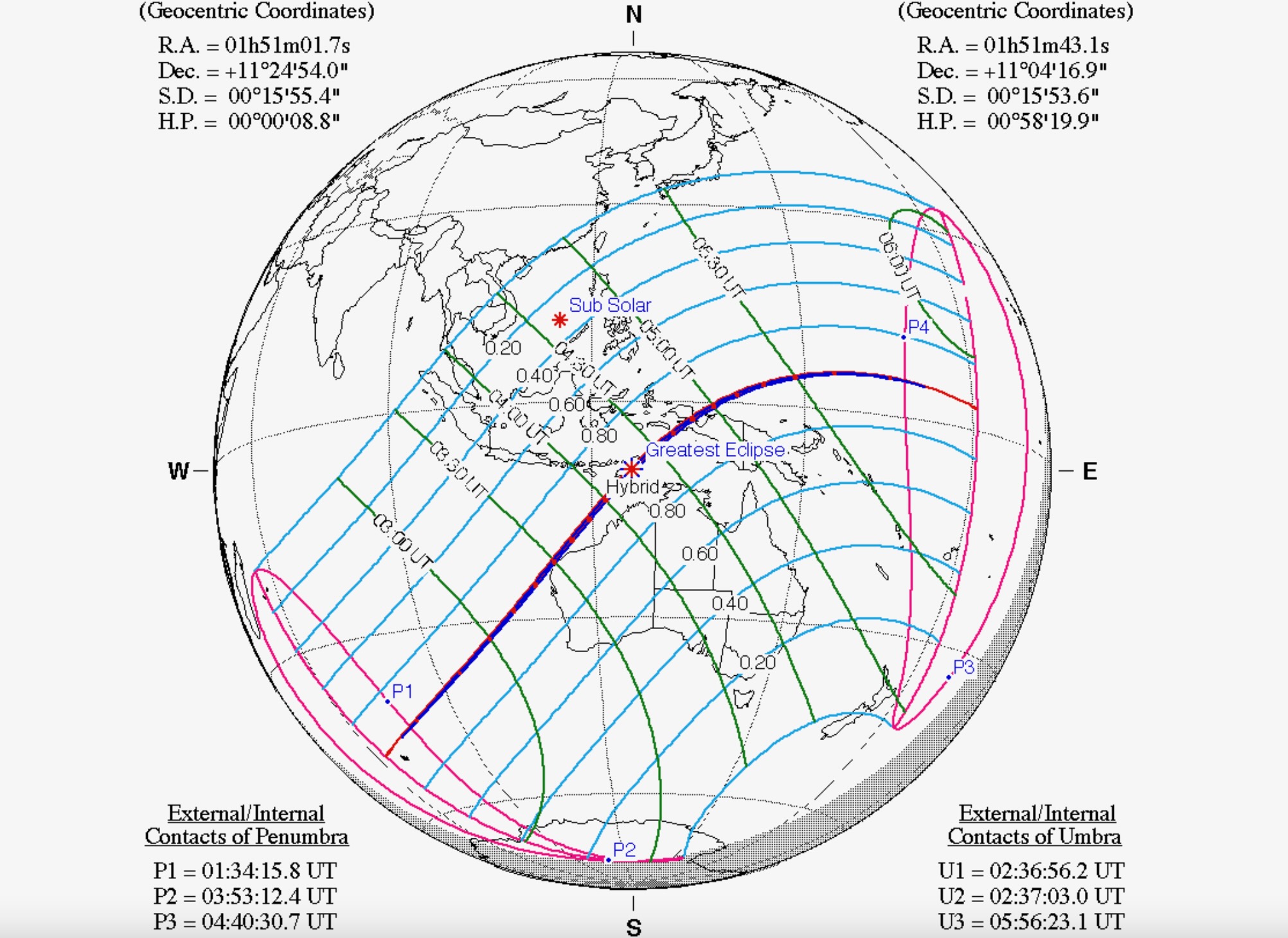Get ready for a rare hybrid solar eclipse on April 20
It will be visible from parts of the Pacific and Indian Ocean regions.

On April 20, parts of the Pacific and Indian Ocean regions will experience a rare type of event called a hybrid solar eclipse.
Hybrid solar eclipses shift from total to annular as the moon's shadow races over Earth; in some places, the moon completely blots out the sun, whereas in others a ring of light is visible around the edge of our natural satellite. These eclipses are quite rare, occurring just a few times every century — and one will grace our planet's skies less than two weeks from now.
While not observable from the U.S., the hybrid eclipse will be visible from western Australia, East Timor, and eastern Indonesia beginning at 21:36 EDT on April 19 (0136 GMT on April 20) and ending at 2:59 a.m. EDT (0659 GMT) on the following day, according to In the Sky. (It will be April 20 in those regions where the eclipse is visible.)
Related: Hybrid solar eclipse: Everything you need to know about the rare and strange phenomenon
Some skywatchers in this region will be treated to a total solar eclipse, whereas others will see a "ring of fire" annular eclipse. Still others will witness a partial solar eclipse, with the moon taking a bite out of a portion of the sun.
There are two points on Earth where the eclipse will transition from annular to total to annular again. However, those two spots are remote locales in the middle of the ocean, Space.com’s Jamie Carter pointed out in an explainer about the April 20 hybrid eclipse.
This hybrid eclipse will appear as a total or annular solar eclipse when viewed from Western Australia from 10:29 p.m. to 10:35 p.m. EDT on April 19 (0229 to 0235 GMT on April 20), in East Timor from 11:19 p.m. to 11:22 p.m. EDT (0319 to 0322 GMT) and in Indonesia from 11:23 p.m. to 11:58 p.m. EDT (0323 to 0358 GMT).
Breaking space news, the latest updates on rocket launches, skywatching events and more!
The celestial event will appear as a partial eclipse from many more countries, including the French Southern Territories, where 93% of the sun will be eclipsed; Papua New Guinea, where 87% of the sun will be blocked; and the Marshall Islands, where 95% of the sun’s disk will be covered by the moon, according to In the Sky.
Hybrid eclipses happen due to the fact that Earth is curved and the moon’s shadow has different regions, particularly a darker central region known as the umbra and a lighter outer region, the penumbra. Hybrid eclipses occur when the moon is as far away from Earth as it can be in its elliptical orbit, while still having the umbra meet the surface of our planet.

"The moon is just at the right distance from Earth for the apex of its cone-shaped shadow to be slightly above the Earth's surface at the beginning and end of the eclipse path, causing the moon's antumbral shadow to move across Earth, causing an annular solar eclipse," Carter wrote in his explainer piece. "However, in the middle of the eclipse path, the apex of the moon's umbral shadow strikes Earth's surface because that part of the planet is slightly closer to the moon."
The last eclipse of this type occurred almost 10 years ago, on Nov. 3, 2013. The next hybrid solar eclipse after this month's will occur in November 2031 and will be visible from some parts of the contiguous United States. After this, the next time skywatchers will get to see a hybrid eclipse is on March 23, 2164.
If you’re hoping to catch a look at this hybrid eclipse you should take precautions not to look directly at the sun without protective equipment, as detailed here in our guide to safe solar observations. Our guides to the best telescopes and best binoculars are also a great place to start if you are looking to observe the eclipse. If you’re looking to snap photos of the night sky in general, check out our guide on how to photograph the moon, as well as our best cameras for astrophotography and best lenses for astrophotography.
Editor’s Note: If you snap an image of the hybrid eclipse and would like to share it with Space.com’s readers, send your photo(s), comments, and your name and location to spacephotos@space.com.
Follow us @Spacedotcom on Twitter, or on Facebook and Instagram.

Robert Lea is a science journalist in the U.K. whose articles have been published in Physics World, New Scientist, Astronomy Magazine, All About Space, Newsweek and ZME Science. He also writes about science communication for Elsevier and the European Journal of Physics. Rob holds a bachelor of science degree in physics and astronomy from the U.K.’s Open University. Follow him on Twitter @sciencef1rst.
